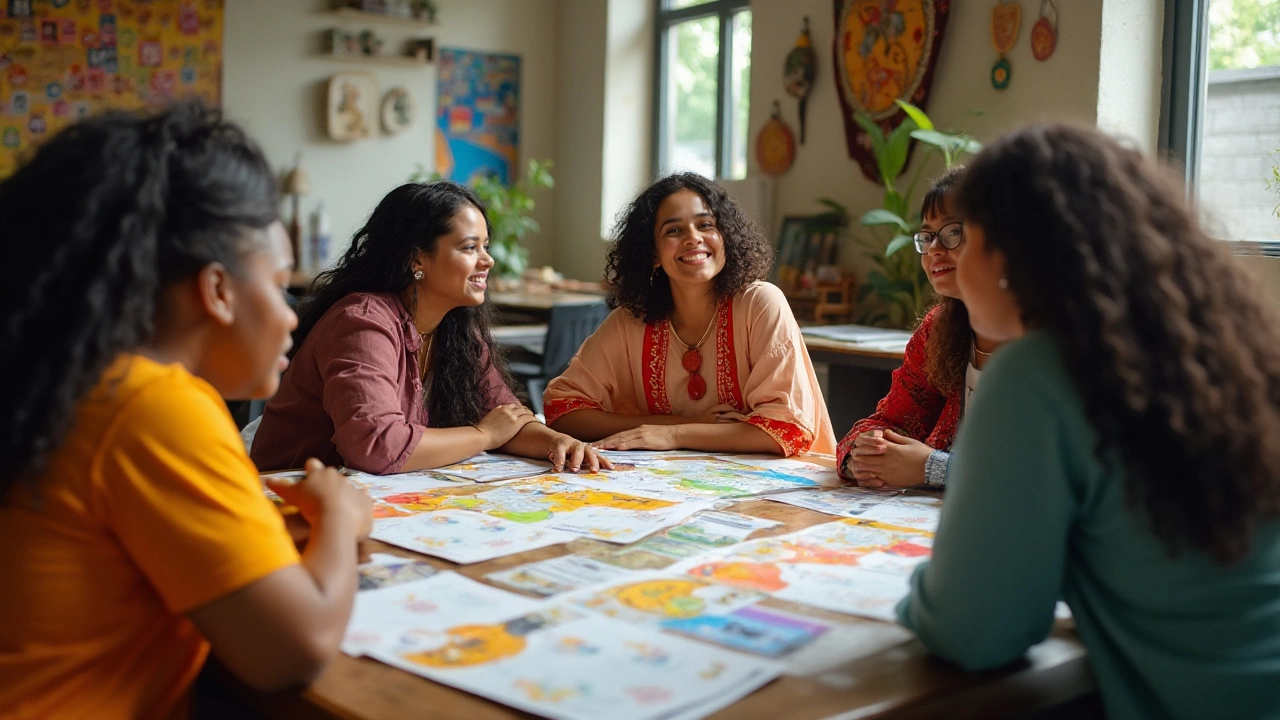
- Created by: Lydia Carmichael
- Completed on: 19 Dec 2024
- Categories: Community Support
Community outreach programs act as vital bridges between resources and those who need them most. They thrive on collaboration and commitment from both the organized team and community members themselves. The success of these programs hinges on clearly defined roles—each contributing unique efforts to meet the diverse needs of communities.
In this exploration, we delve into the integral roles that make community outreach effective and the skills these positions typically require. We will uncover the complexities and challenges faced, providing practical guidance for overcoming them. Whether you're a seasoned coordinator or a budding volunteer, understanding these dynamics is crucial for fostering meaningful connections and catalyzing positive change in society.
- Understanding Community Outreach
- Identifying Key Roles in Outreach Programs
- Essential Skills for Outreach Success
- Challenges and Solutions in Community Engagement
- Tips for Effective Community Outreach
Understanding Community Outreach
Community outreach is a dynamic process that embodies the essence of building bridges between individuals, organizations, and societal resources to address community needs. At its core, outreach strives to empower communities, often focusing on populations that are underserved or marginalized. Through strategic engagement and partnerships, outreach programs aim to provide access to essential services, as well as foster education, health, and economic development opportunities. The essence of community outreach is about listening to the community’s voice, understanding its distinct challenges, and collaboratively crafting tailored solutions that resonate with the locals.
To truly grasp the impact of outreach, consider its multifaceted nature. It involves a blend of planning, direct interaction, and continuous adaptation to the evolving landscape of community needs. For instance, an outreach program aimed at improving local healthcare might focus on educating communities about preventive measures and facilitating access to medical screenings or vaccinations. Such programs are not static; they require ongoing assessment and management to adapt to changing circumstances. Accentuating this point, renowned community organizer Jane Addams once said,
"The good we secure for ourselves is precarious and uncertain until it is secured for all of us and incorporated into our common life."This reinforces the notion that successful community outreach is deeply rooted in collective well-being and shared progress.
Community outreach also thrives on collaboration and strategic alliances. Partnerships with local organizations, governmental bodies, and businesses can amplify the reach and efficacy of these programs by pooling resources and expertise. Local businesses, for example, might provide sponsorships or in-kind contributions, while governmental bodies can assist by facilitating necessary permits and resources. An integral part of this collaboration is the involvement of community members themselves, as their insights and feedback are crucial for aligning program efforts with actual needs.
The power of outreach is also reflected in its ability to instigate long-term behavioral changes and sustainable development. Programs that are well-informed and rooted in the community's cultural and social fabric tend to yield more profound and lasting impacts. For example, a strong community outreach initiative may not only address immediate needs—such as hunger or homelessness—but also work to create educational opportunities and job training programs that break the cycle of poverty. By doing so, outreach programs contribute to building resilient communities equipped to handle future challenges autonomously.
Moreover, successful community outreach initiatives are guided by data-driven strategies and clear goals. Tracking progress and measuring outcomes are vital for understanding program effectiveness and informing future actions. Such evaluations might involve gathering qualitative data through surveys, interviews, or anecdotal feedback from participants, as well as quantitative metrics like attendance figures or improvements in relevant indicators. This balance of quantitative and qualitative assessment provides a nuanced picture of where adjustments might be needed and highlights areas of success.
As we uncover the layers of community outreach, it becomes clear how crucially it can serve as a conduit to improving lives and inspiring change. Whether through education, advocacy, or direct service provision, outreach programs strive to bridge gaps and strengthen the social fabric of communities everywhere. The ultimate aim is to nurture empowered and self-sufficient communities that can themselves become agents of change, illustrating an ever-expanding ripple effect of positive impact.
Identifying Key Roles in Outreach Programs
When delving into the intricacies of community outreach programs, understanding the roles involved is paramount. Each role holds its own unique set of responsibilities, finely tuned to contribute towards the community's well-being. To fully comprehend these positions, let’s walk through some key roles typically found in such initiatives. First on the list are coordinators, who might be viewed as the heart of outreach efforts. Their job involves planning and managing programs, ensuring all elements come together smoothly. These individuals often possess strong leadership skills and have a knack for problem-solving, essential for keeping things on track.
Project managers also play a critical role, taking charge of detailed logistical planning. These professionals make sure that outreach events are conducted efficiently, aligned with organizational goals. Another crucial role is that of outreach workers or community liaisons. They act as messengers, bridging the gap between the program and the community. Their deep understanding of local needs enables them to communicate effectively with community members, fostering trust and open communication.
Volunteers form the backbone of many outreach programs, delivering services directly to the community. Whether organizing events, distributing materials, or providing education, their contribution cannot be overstated. According to a study, volunteers increase their confidence and skills markedly over time, benefiting both their personal growth and the program.
"Volunteers do not necessarily have the time; they just have the heart," as Elizabeth Andrew beautifully puts it.
Community engagement leaders, another vital component, focus on building and sustaining relationships. They often have a background in social work or community organization, providing the necessary skills to foster long-term engagement. Admin staff, though often working behind the scenes, are indispensable. They manage records, handle communications, and support all other roles. Their organizational skills keep everything running smoothly, ensuring the program's sustainability.
Each of these roles requires a specific set of skills and attributes, contributing uniquely to the program’s mission. The diversity in roles allows outreach programs to be dynamic and adaptable, ready to meet the evolving needs of their communities. Understanding these roles provides clarity and direction for individuals seeking to get involved, as well as organizations aiming to optimize their efforts.

Essential Skills for Outreach Success
Community outreach programs thrive on the dedication and abilities of those involved, making essential skills the bedrock of their success. At the heart of any effective outreach effort lies communication, bridging the gap between the organization and the community. It is vital to convey messages clearly to diverse audiences while actively listening to their needs and feedback. Mastering both verbal and written communication can transform how communities perceive and participate in programs, fostering stronger relationships and trust.
Another pivotal skill is organization. Effective community outreach requires meticulous coordination of events, volunteers, and resources. Organizational skills enable program leaders to manage tasks efficiently, setting priorities without overwhelming team members. This involves setting realistic goals, creating timelines, and ensuring that essential tasks are not sidelined. A disciplined approach to organization can transform program execution, enhancing the impact and sustainability of outreach initiatives.
Building Empathy and Cultural Competency
Empathy plays a crucial role in community outreach, as understanding and relating to the community's emotions can better tailor initiatives to address real concerns. Empathy fosters a sense of respect and inclusivity, breaking down barriers that might otherwise hinder communication and engagement. It’s about taking the time to learn the stories and struggles unique to each community, forming the basis for more impactful interventions.
Moreover, cultural competency is an indispensable asset in today's diverse societies. It encompasses an awareness and appreciation of different cultural identities and practices, equipping outreach professionals with the insight to navigate interactions sensitively and respectfully. Engaging with communities from varied backgrounds requires recognizing and valuing their cultural norms, which can significantly enhance program reception and participation.
Yet another layer to consider is the importance of adaptability. The dynamic nature of community work means being open to change is crucial. This involves responding effectively to unexpected challenges, whether it’s pivoting program tactics or adjusting strategies to accommodate new community needs. Adaptability ensures that outreach programs remain relevant and effective, aligning with evolving societal contexts and priorities.
Utilizing Data and Evaluation Skills
Finally, the skillful use of data is becoming increasingly important in community outreach. Gathering and analyzing data allows teams to assess the effectiveness of their initiatives, identify areas for improvement, and allocate resources more intelligently. Having strong analytical skills enables outreach workers to interpret trends and patterns, crafting data-driven strategies that enhance program delivery and outcomes. According to the Community Engagement Network, “Informed decision-making rooted in accurate data can elevate outreach efforts to new heights.”
| Skill | Impact on Outreach |
|---|---|
| Communication | Enhances message clarity and community trust |
| Organization | Ensures efficient resource and task management |
| Empathy | Improves community relations and program tailoring |
| Cultural Competency | Facilitates diverse community engagement |
| Adaptability | Maintains program relevance and effectiveness |
| Data Utilization | Drives informed strategy development |
Incorporating these skills into outreach programs can significantly enhance their effectiveness, creating a robust framework for positive community change. Whether you're just starting in community outreach or looking to improve your existing efforts, focusing on these core skills will lead to more successful and sustainable engagement.
Challenges and Solutions in Community Engagement
Engaging with a community through an outreach program is a complex endeavor filled with unique challenges. These challenges can range from logistical hurdles to deeper socio-cultural barriers, each demanding a sensitive and well thought-out approach. One primary challenge is building trust within the community. People are often wary of external interventions, especially in communities that have historically been underserved or misrepresented by similar initiatives. Therefore, establishing credibility and trust is crucial. Programs must demonstrate genuine commitment and consistency in presence and communication.
Another significant obstacle is effectively addressing diverse community needs. Communities are not monolithic; they comprise individuals with varied backgrounds, experiences, and perspectives. Tailoring outreach efforts to accommodate this diversity can be daunting. It requires not only keen observation but an openness to adapt strategies as required. A collaborative approach, where community members are actively involved in planning and decision-making, can mitigate this issue. This inclusive participation ensures that the solutions are not just imposed but are authentic responses to the actual needs. As stated by wise community planner John McKnight, "Effective community work is not about fixing problems, but unleashing potential by seeing individuals as solutions."
Moreover, securing resources and managing them efficiently is often a critical challenge in outreach initiatives. Limited funding, volunteer burnout, and resource allocation can hinder the progress of well-intended programs. Solutions involve strategic planning and sustainable resource management practices. Establishing partnerships with local stakeholders, businesses, and non-profits can bolster resources, creating a support network. This sense of shared responsibility not only enhances resource availability but also broadens the impact of the outreach program.
Communication barriers also pose significant challenges. Language differences, technological gaps, or simply the lack of effective communication channels can obstruct engagement efforts. Overcoming these barriers might involve taking small yet impactful steps like developing multilingual material, employing local liaisons who understand the community dynamics, or leveraging technologies that are most accessible to the community. Utilizing varied communication platforms, from traditional to digital means, can help bridge this gap. A multi-faceted communication strategy ensures that the outreach message is delivered and received as intended.
To further illustrate the diversity in program challenges, consider the importance of data management and impact assessment. Many outreach programs struggle with organizing community data efficiently and using it to assess the impact of their initiatives. Without accurate data, it's difficult to determine the efficacy of a program or areas needing improvement. Investing in data management systems and training can enhance data-driven decision-making and accountability. As shown in a survey by Community Development Alliance, organizations that embrace a structured data analysis approach report a 30% higher success rate in achieving their intended outcomes.
In summary, engaging communities effectively requires a delicate balance of empathy, strategic planning, and adaptability. By understanding and addressing these challenges, outreach programs can foster meaningful and sustained community connections. Encouragingly, each challenge presents a unique opportunity to innovate and strengthen the fabric of community relationships, setting the stage for impactful change.

Tips for Effective Community Outreach
Engaging with a community through outreach programs requires a strategic approach and a genuine empathy for the people you aim to serve. A primary step in ensuring effective community outreach is to thoroughly understand the community you plan to work with. This involves not just listening to the spoken needs, but observing the unspoken nuances that can truly reveal where your efforts should be focused. Engaging community leaders early on can provide valuable insights and help build trust, which is essential for success. Establishing clear, attainable objectives while remaining flexible enough to adjust as needed will keep the program on track and responsive to any changes in community dynamics.
Before diving headlong into program activities, consider developing a robust plan that includes measurable goals. Cultivating a team of dedicated individuals who bring diverse perspectives is crucial. Each team member should have specific roles that align with their strengths, allowing them to contribute effectively to the initiative. A regular feedback loop where you actively solicit and incorporate input from community members can significantly enhance the program's impact. It is also helpful to use multiple communication platforms to reach different segments of your audience—some might prefer social media, while others might be more responsive to in-person meetings or newsletters.
In the words of Helen Keller, "Alone we can do so little; together we can do so much."
To foster sustained engagement, transparent communication is key. Regular updates on progress and any adaptations in the program plan can help maintain trust and enthusiasm among participants and stakeholders. Celebrating milestones, no matter how small, reinforces the community's involvement and progresses toward those outlined objectives. Additionally, leveraging technology can augment your efforts—whether through the effective use of social media to spread awareness, or by employing online tools for virtual meetings or data gathering. This, combined with a genuine, positive presence in the community, can create lasting relationships that benefit all involved.
Monitoring and evaluation are integral to understanding the effectiveness of your outreach activities. Establishing a baseline before beginning can aid in comparative analysis over time. It's important to remember that outreach efforts are not static and should evolve based on the feedback you receive. Regular evaluation sessions should be conducted to assess whether the goals are being met, what challenges have arisen, and how these challenges can be addressed moving forward. Engagement doesn't end when a specific program does; keep in touch with the community to uncover areas of further support and collaboration. The key is to act as a partner in the development process, not as an outside problem-solver stepping in temporarily.
Finally, resources and support are the backbone of any outreach program. Securing sustainable funding is important but remember that resources aren't just financial. Human resources—time, skill sets, and sheer human passion—are invaluable. Encourage volunteerism by highlighting the tangible change that these efforts can bring about. Attract attention to the overarching mission of the outreach program, so volunteers and donors see the real impact of their contributions. Continuously expand your resource network by involving individuals, businesses, and organizations that resonate with the outreach mission. This collective approach helps ensure that the program not only survives but thrives, propelling positive outcomes for the community at large.